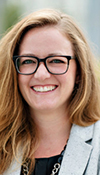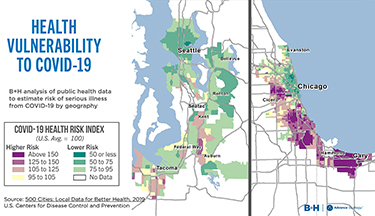|
Subscribe / Renew |
|
|
Contact Us |
|
| ► Subscribe to our Free Weekly Newsletter | |
| home | Welcome, sign in or click here to subscribe. | login |
Construction
| |
 |
July 29, 2021
Next-gen health care: Building healthier communities, economies
B+H Architects

Benson
|
What if the future of health care is operated primarily by people without advanced degrees? And a clinic is not so much a clinic as we think of it today, but rather more like a distribution center with community connections?
In the United States, access to health care most often requires the ability to secure health insurance, yet globally, even in countries with nationally funded health systems, income remains one of the strongest predictors of health outcomes. In the U.S., zip code is the single most relevant indicator of population health.
There are three critical barriers to access:
• Physical distance and poor transit connections.
• Awareness.
• The digital divide.
DOCTOR SHORTAGES
In the rural U.S., there is one doctor for every 11,000 square miles. Geographically speaking that’s the equivalent of 23 doctors in the whole of France. Eighty percent of the rural population is medically underserved.
LACK OF AWARENESS
But even access to health care does not guarantee good health outcomes. One Medicaid study that tracked Medicaid patients who were placed into affordable housing found that the cost of delivering care to these residents decreased by 12% overall and, most significantly, that they experienced a 38% increase in the quality of their health. A critical factor in this success was the location of services such as free transportation to clinics or on-site support staff. The study demonstrated that many Medicaid recipients are unaware of the availability of care.
THE DIGITAL DIVIDE
COVID-19 changed the way we access health care, almost overnight. In February 2020, 0.1% of primary care visits among Medicare patients were conducted virtually; by April 2020, that number had risen to 43%. For many this digital evolution increases access to health care. Yet, 42 million Americans, nearly all in rural and already underserved populations, could not access the internet even if they could afford it as the infrastructure simply does not exist.
Is the solution more advanced medical facilities and greater numbers of providers? We think part of the solution may be much simpler than that.
If physical space and economic health are intertwined, then shouldn’t we be thinking about creating economic opportunity and addressing social inequity as part of a public health strategy?
Imagine what might change if a retail manager with two children could stop on the way home from school pickup for a checkup with her lifelong provider at a place where her kids can start on their schoolwork and she can attend night classes? What if a fisherman could jump off the boat in any port, meet with their family doctor and the specialist for their rotator cuff injury, and check in on plans for their family reunion?
What if the future of health care isn’t a new kind of clinic, but a resource center with community connection and virtual workspace?
TELEHEALTH LIBRARIES
To increase access to health care and improve outcomes, we propose Telehealth Libraries. These facilities would provide access to virtual doctors, lend at-home health diagnostic and monitoring equipment, and access to internet and workspaces. The on-site operation could be staffed largely by people who focus on customer experience and do not require an advanced formal education.
What kind of services would a Telehealth Library provide?
• Equipment lending.
• Telemedicine access.
• Customer service/basic health advice/help with technology.
• Workstations/high-speed internet.
• Flexible hours that accommodate workers on night shift or people working two jobs.
• Educational resources about nutrition, diabetes care, exercise, etc.
• Access to mental health counseling via virtual consultation rooms.
• Guided mediation space (access to services such as Headspace or Calm).
What does the Telehealth Library look like?
• Communal/approachable with privacy nooks.
• Private telemedicine consultation rooms.
• Lounge workstations for open use.
• A welcoming, service-oriented environment.
• Device desk, home health equipment lending “library.”
• A soothing, calming environment with biophilic elements.
• Universal design to accommodate all mobility needs.
Where should Telehealth Libraries be located?
The libraries could be located in areas that are already essential destinations for the populations they serve. They would be noticeable and raise awareness of health needs while making it easy for people to access.
• In or near community spaces.
• Next to public transit.
• In or near a school.
• Places of convenience such as gas stations or grocery stores.
In suburban and rural America, most roads eventually lead to a mall. These locations are ideal for reinvention and already have much of the necessary infrastructure to support a Telehealth Library.
With all the trials and tragedy the COVID era has brought, one of the bright spots is that it’s given us space and time to think about what works and what doesn’t in our society. Health care is certainly in the top three. By embracing the potential of technology and changes in people’s behavior, these libraries could create a center for community and well-being in neighborhoods and rural areas that have a history of disinvestment and disenfranchisement. Imagine the Telehealth Library as a catalyst for more equitable economic development across the globe. We have the opportunity to invest in building healthier communities which will, in rapid succession, lead to healthier economies.
Sara Benson is a senior strategist at B+H Architects.
Other Stories:
- Aggregation will drive a new hybrid science space
- Alternative delivery benefits health care in Washington
- Micro hospitals offer the right prescription
- The shape-shifting needs of the health care industry
- Best practices in health care development and delivery
- How flexible design served OHSU during the pandemic
- The shifting need for design in health care services
- Evidence-based design improves dialysis treatment experience
- Compounding pharmacies provide community resource



